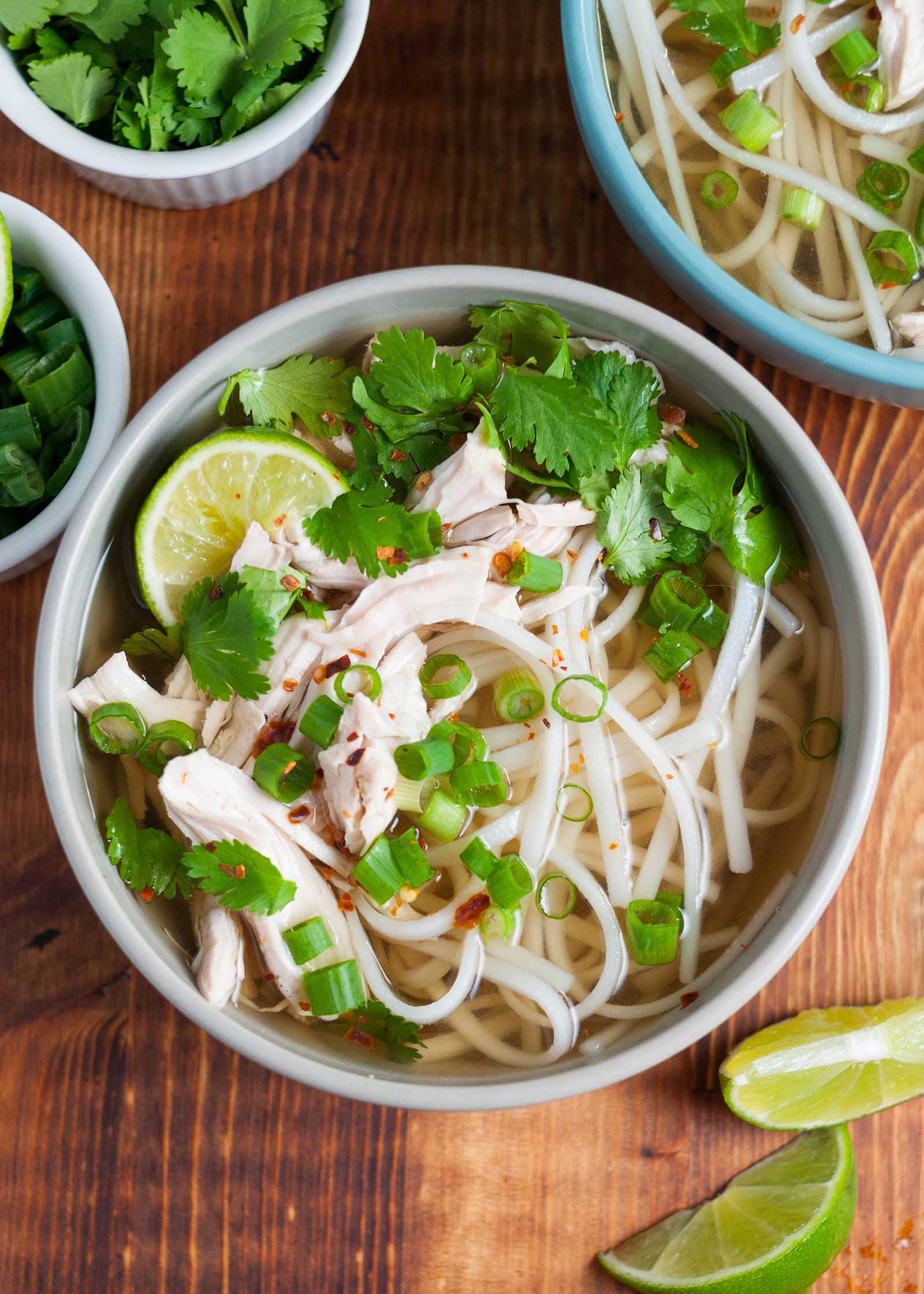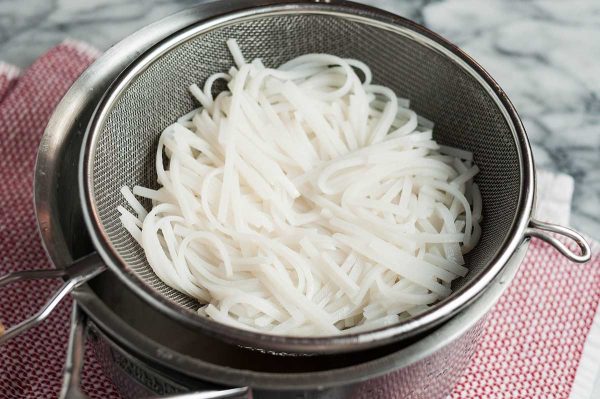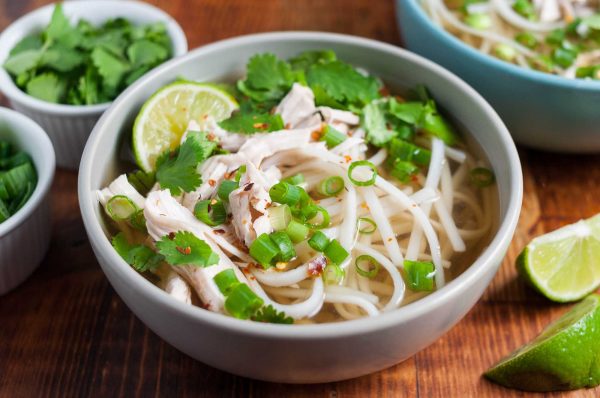Quick Chicken Pho

A few years ago, I’d never even heard of pho, let alone tasted it. Now, giant bowls of this traditional Vietnamese noodle soup are a regular meal in our house. There are three things I can thank for this change: 1) Moving to a part of the country where pho restaurants are as common as pizza joints. 2) Several months of gluten-free eating last year due to a health issue. 3) Meeting and becoming friends with Vietnamese cooking expert Andrea Nguyen. Andrea has now published a new book entirely devoted to — what else?! — pho, and I’d like to share with you her recipe for Quick Chicken Pho. This recipe is a great introduction to pho if you’ve never had it before. And for pho addicts like myself, it’s a good one to have around when a pho-craving strikes. Get the book! The Pho Cookbook: Easy to Adventurous Recipes for Vietnam’s Favorite Soup and Noodles by Andrea Nguyen There are so many things to love about Andrea’s new cookbook, and not just the recipes! In Andrea’s own words when I spoke with her about it, “This cookbook contains 99% of what I know about pho. And the other 1% isn’t all that interesting.” Again and again, Andrea underscores the idea that pho is not a fussy or difficult dish to make at home. There are no laborious prep requirements or unfamiliar techniques to master. Really, if you can boil water, you can make pho. This is because, with pho, it’s really all about the broth. The noodles and bits of tender meat definitely have curb appeal and make the soup into a substantive meal, but all the real flavor and allure of pho comes from a slow-simmered broth. Making a good pho broth will feel familiar to anyone who has ever made their own chicken stock or beef stock. The process is almost exactly the same, except for the addition of a few uniquely Vietnamese ingredients like star anise, cinnamon, ginger, soy sauce, and fish sauce. These extra ingredients give pho its seductive personality and trademark balance of sweet, salty, and savory flavors. Of all these ingredients, fish sauce is likely to be the least familiar to most of us. It’s exactly what it sounds like: a sauce made from fermented fish. It has an intense flavor and super-pungent aroma, like concentrated anchovies. You might be dubious about adding this to your food, but give it a chance! Fish sauce adds a deep (and surprisingly non-fishy) flavor to foods. Once added, it melts into the background. You won’t necessarily be able to pick it out of the crowd, but you’d miss it if it weren’t there. My favorite brand is Red Boat Fish Sauce, but just about any brand that you find is sure to get the job done. I’ve started seeing bottles of fish sauce carried in the Asian ingredients section of major grocery stores in the past few years, but you can also order it online or seek it out at an Asian grocery store. Once the broth is simmering, all the real work is done! Assembling your bowl of pho is a matter of softening some rice noodles, adding some shredded chicken or beef (which is often cooked right in the simmering broth), and then ladling the steaming hot broth over top. Cool pho fact: If you add thinly-sliced steak to your pho, the hot broth actually does the job of cooking the meat! Garnish your bowl with fresh bean sprouts, sprigs of mint, cilantro leaves, and a lime wedge, and chow down. Slurping is totally encouraged. This particular recipe for Quick Chicken Pho takes a few shortcuts to save you some time, but still makes a very respectable bowl of pho. Instead of making the broth from scratch, pick up a carton of store-bought broth and give it a quick simmer with some herbs and spices to boost the flavor. A chicken breast or a few thighs cooked in the broth adds even more flavor and gives you with enough shredded meat for your dinner. To avoid ending up with an overly-concentrated broth after simmering, Andrea has you add some water to the broth. I felt that this also helped the broth hit the balanced flavor and lightness in a true pho broth. The whole meal is ready in about a half an hour, which means a bowl of pho is totally doable on a busy weeknight. Once you’ve mastered this quick pho, Andrea has plenty of other recipes for you to try next, including a classic slow-cooked Chicken Pho made with a whole chicken. I also tried her recipe for Pressure Cooker Beef Pho and can honestly say that it was one of the best bowls of pho I’ve ever had in my life — homemade or at a restaurant. That recipe gets a giant thumbs up! I’m also excited to try some of the more offbeat recipes from Andrea’s book, like the Wok-Kissed Beef Pho with stir-fried beef and her Pho Fried Rice. There are so many variations of pho in this book that there’s sure to be a recipe that suits every person’s tastes, time, and skill. With each one, Andrea takes the time and effort to walk us through every step and possible pitfall, helping us to craft the perfect bowl of pho. Three cheers to Andrea for this fun new addition to our cookbook shelves! Get the book! The Pho Cookbook: Easy to Adventurous Recipes for Vietnam’s Favorite Soup and Noodles by Andrea Nguyen
From Andrea:
"Great for pho beginners, this recipe is also terrific for cooks in a hurry. It involves less than 45 minutes, during which you’ll doctor up store-bought broth so it says, “I’m pho-ish.”
The keys to this streamlined approach include toasting spices and dry sautéing the ginger and green onion, which help to extract flavor fast. Poaching the chicken in the broth adds savory depth. You’ll practice some fundamental pho techniques that you can apply elsewhere, too. Choose a broth that tastes like chicken, such as Swanson brand, which is less fussed up and easy to manipulate. You need two 14.5-ounce (411 g) cans or one 32-ounce (907 ml) carton."
1 Prepare the broth ingredients: Peel then slice the ginger into 4 or 5 coins. Smack with the flat side of a knife or meat mallet; set aside. Thinly slice the green parts of the green onion to yield 2 to 3 tablespoons; set aside for garnish. Cut the leftover sections into pinkie-finger lengths, bruise, then add to the ginger.
Coarsely chop the leafy tops of the cilantro to yield 2 tablespoons; set aside for garnish. Set the remaining cilantro sprigs aside.
2 Toast the broth ingredients: In a 3- to 4-quart (3 to 4 l) pot, toast the coriander seeds and clove over medium heat until fragrant, 1 to 2 minutes. Add the ginger and green onion sections. Stir for about 30 seconds, until aromatic.

3 Add the broth and bring to a simmer: Slide the pot off heat, wait 15 seconds or so to briefly cool, then pour in the broth.
Return the pot to the burner, then add the water, cilantro sprigs, chicken, and salt. Bring to a boil over high heat, then lower the heat to gently simmer for 30 minutes.

4 While the broth simmers, soak the rice noodles in hot water until pliable and opaque. Drain, rinse, and set aside.


5 Remove the chicken from the broth once cooked: After 5 to 10 minutes of simmering, the chicken should be firm and cooked through (press on it and it should slightly yield).
Transfer the chicken to a bowl, flush with cold water to arrest the cooking, then drain. Let cool, then cut or shred into bite-size pieces. Cover loosely to prevent drying. [Emma's note: If the chicken isn't quite cooked through when you begin to shred it, just split it into a few pieces and put it back in the broth for another few minutes until cooked through. The split pieces will quickly cook through.]


6 Strain the broth: When the broth is done, pour it through a fine-mesh strainer positioned over a 2-quart (2-liter) pot; line the strainer with muslin for superclear broth. Discard the solids. You should have about 4 cups (1 l).
Season with fish sauce and sugar (or maple syrup), if needed, to create a strong savory-sweet note.



7 Finish the pho: Bring the strained broth to a boil over high heat. Put the noodles in a noodle strainer or mesh sieve and dunk in the hot broth to heat and soften, 5 to 60 seconds. Lift the noodles from the pot and divide between the 2 bowls. [Emma's note: I didn't find it necessary to soften my noodles any further. I just added them to the bowls and poured the hot broth over top. However, dunking them in the broth would make them more flavorful!]
Lower the heat to keep the broth hot while you arrange the chicken on top of the noodles and garnish with the chopped green onion, cilantro, and a sprinkling of pepper. Taste and adjust the broth’s saltiness one last time. Return the broth to a boil and ladle into the bowls. Enjoy with any extras, if you like.
[Emma's note: I just left the broth at a low simmer during this last step, rather than bringing it to a boil again. I thought it was plenty hot!]


